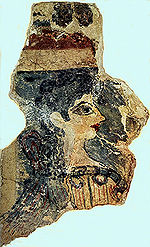
La Parisienne
Encyclopedia

Knossos
Knossos , also known as Labyrinth, or Knossos Palace, is the largest Bronze Age archaeological site on Crete and probably the ceremonial and political centre of the Minoan civilization and culture. The palace appears as a maze of workrooms, living spaces, and store rooms close to a central square...
. The sacral knot
Snake Goddess
Snake Goddess, indicates figurines of a woman holding a snake in each hand found during excavation of Minoan archaeological sites in Crete dating from approximately 1600 BCE.It seems that the two elegant idols found in Knossos represented goddesses and by implication, the term 'snake goddess'...
worn at the back of the neck seems to indicate that she is a priestess or even a goddess.
The archaeological research in Minoan palaces, cemeteries and settlements has brought to light a multitude of objects related to beautification.
It seems that there were beautification areas in the palaces of Knossos
Knossos
Knossos , also known as Labyrinth, or Knossos Palace, is the largest Bronze Age archaeological site on Crete and probably the ceremonial and political centre of the Minoan civilization and culture. The palace appears as a maze of workrooms, living spaces, and store rooms close to a central square...
, Zakros
Zakros
Zakros is a site on the eastern coast of the island of Crete, Greece, containing ruins from the Minoan civilization. The site is often known to archaeologists as Zakro or Kato Zakro...
and Pylos
Pylos
Pylos , historically known under its Italian name Navarino, is a town and a former municipality in Messenia, Peloponnese, Greece. Since the 2011 local government reform it is part of the municipality Pylos-Nestoras, of which it is the seat and a municipal unit. It was the capital of the former...
. These beauty objects were used during the whole Aegean Bronze Age. By using these objects, the Minoan ladies highlighted the red lips and the white of the face. In the fresco
Fresco
Fresco is any of several related mural painting types, executed on plaster on walls or ceilings. The word fresco comes from the Greek word affresca which derives from the Latin word for "fresh". Frescoes first developed in the ancient world and continued to be popular through the Renaissance...
of the Parisienne, the use of the black colour for emphasizing the form of the eyes and red for the lips can clearly be seen.
It dates from the Neopalatial period, ca. 1400 B.C., and is currently in the Herakleion Archaeological Museum.

